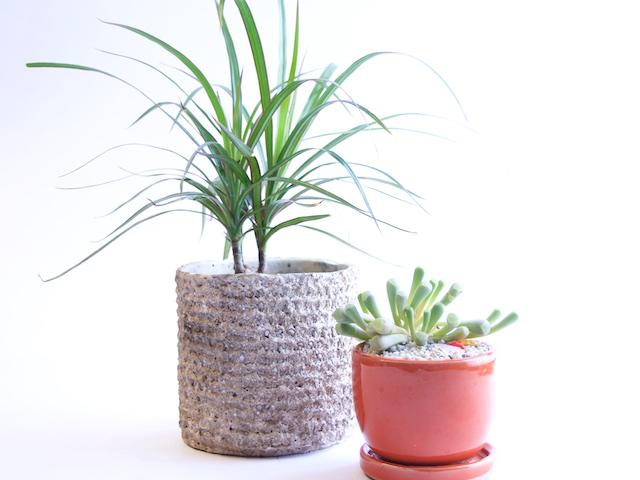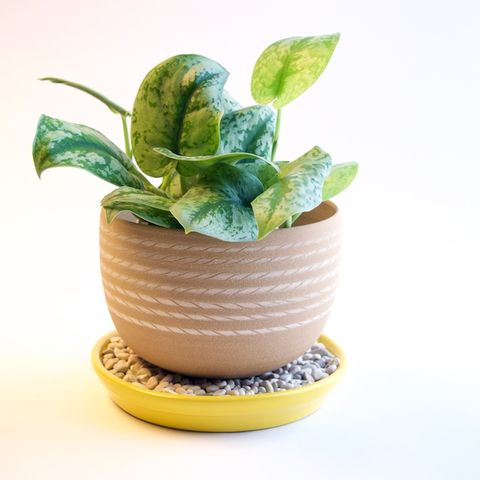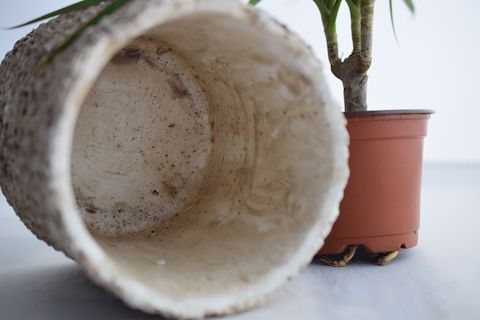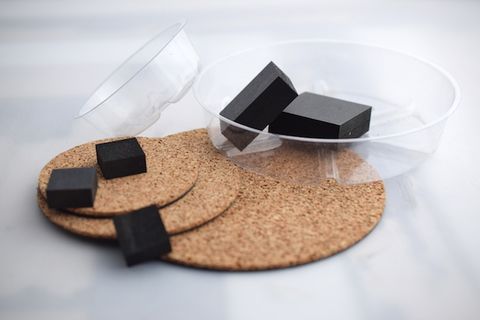
Houseplants: Does Your Planter Need a Saucer?
Most planters don’t come with saucers—and some don’t even have holes. Learn how to use cachepots and saucers and when and how to water.

Not a day goes by in our store, Potted, that someone doesn’t ask about whether they need a saucer, especially with houseplants. It’s a good question because most planters don’t come with saucers—and some don’t even have holes. Here’s everything you ever wanted to know about using saucers with houseplants:
Basic plant and planter facts:
- Almost every plant needs drainage (except water plants)
- Using rocks instead of drainage only kinda works sometimes—and only if you’re really lucky
- Every ceramic pot and saucer has the potential to “sweat” if left with standing water in them (meaning: the water could damage the surface below)
So how do you deal with these issues? Well if you’re lucky enough to find a matching pot and saucer, like the one above, do a happy dance. On a sunny windowsill, this plant would do great and nothing would be damaged beneath it as long as you’re not watering it there (more on that later). Alas, the chance of finding a matching saucer like this is not good. And if the pot is an irregular shape, what do you do then?

My solution for making odd saucers work is to pretend that I meant it to be that way. I fill them with pretty rocks, glass, or marbles and celebrate their happy union. As you can see from the example I created above, it’s easy and actually looks good. This gorgeous planter by Austin-based Foxwares Ceramics came with a hole, so I absolutely had to find a saucer solution and I think it works great.

But what happens if you don’t have a hole? A planter without a hole is called a cachepot, which is French for “to hide a pot.” This is how I have every one of my 24 houseplants (yes, 24). The beauty of the cachepot is that you don’t need to worry about finding a saucer—and you don’t risk ruining the beauty of the pot with an ugly saucer. I leave all my houseplants in their original nursery containers, which have excellent drainage, and merely set them inside the cachepot, allowing the planter to essentially become the saucer.
I don’t water my plants in their cachepots—or on top of their ceramic saucers—because it’s too easy for water to build up and seep through. Instead, when it’s time to water, I take my plants to the sink for a good soak and put them back into their homes once they’ve drained through, which takes about a minute each. It’s super easy and my plants thrive.

The following items (shown above) can also be really helpful:
- Cork pads: I use these under the saucer of any plant that I have potted in soil and intend to water in its pot. The pad keeps the planter from scratching the surface I’ve put it on, and its plastic backing keeps any “sweating” the saucer may produce from damaging wood surfaces. You can also use cork pads as saucers under small planters with plants that don’t require a lot of water, like succulents; I use them under my cachepots for the same reason. It may seem like overkill, but every pot will leak at some point—hopefully not on your vintage oak table.
- Plastic saucers: I use these to make a planter with a hole into a cachepot by putting the saucer inside the planter. (You could use these as actual saucers, but I think they are a little unsightly and I’ve never found any amount of rocks that could make them look otherwise.)
- Rubber pot risers: These work by lifting the pot off the ground and providing good air circulation. I only use these on larger plants that I can’t take to the sink to water. What I do is elevate the plant inside the cachepot with the risers so there is much less chance of them sitting in water (make sure you use a cork pad under the planter, as you will have standing water from time to time).Of course, the best use for pot risers is outside on a deck. I often see people buying saucers for their deck plants because they think they are protecting the wood and are then horrified when they move the planter and see everything rotted underneath. The saucer is no different than the planter … it’s trapping water underneath, and without a chance to dry out, it’s going to cause rot.

Guest blogger Annette Gutierrez is the co-owner of Potted garden and outdoor-living shop in L.A.’s Atwater Village.
